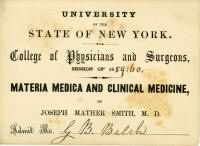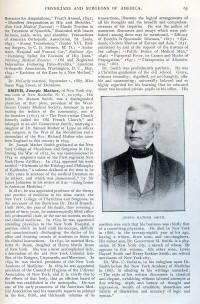Joseph Mather Smith, M.D.
Click image to enlarge
Smith, Joseph Mather (1789-1866) "Forty years a public teacher in medicine, forty-six years constantly concerned in the active duties of public hospitals; for more than thirty years a consulting physician whose practical advice was widely sought by his confreres" is a good introduction to the child who was born to Dr. Matson Smith and his wife in New Rochelle, New York, March 14, 1789. His mother was a descendant of the Mather family of Massachusetts. Joseph was educated in the academy of his native town, graduated at the New York College of Physicians and Surgeons in 1815 and served as surgeon's mate during the War of 1812. In 1824 he published his treatise on the "Elements of the Etiology and Philosophy of Epidemics," which Sir James Johnston, reviewing in the Medico-Chirurgital Review, described as characterized not only by great ability and force of argument, but also by candour and talent, doing honor to American medicine.
Four years as visiting physician to the State Prison; fighting the typhus which broke out there and in the Bellevue Almshouse in 1825, and three outbreaks of yellow fever, gave him a good and valued experience in epidemics. When, in 1831, an outbreak of cholera was announced in Europe, Dr. Smith set to work preparing to prevent or combat it, should it reach America. He traced its progress in all parts of the world, so that, when it came in 1849 he and his confreres, Beck and Moore, were ready. Record work was done in fighting the pestilence and every day the doctor met the municipal committee to confer. The following year Dr. Smith gave to the American Medical Association a lengthy and valuable report on "Hygiene and Preventive Measures in Case of Possible Epidemics," and 1860 saw his exhaustive treatise on the "Medical Topography and Epidemics of the State of New York," in which geology, geography, botany, hydrology, and meteorology are made to throw all possible light on the subject.
Even when seventy years had passed, with faculties untouched by time, he worked away at all hygienic reforms and everyone knows what cheerful work that is and the dull-headed opposition it provokes. Specially he encouraged and honored the sanitary inspectors and never failed to be present at their meetings.
On the morning of April 22, 1866, seventy- eight years old, he completed an earthly career of useful deeds. The Bible had for many years been his daily counsellor and sanctified the fireside.
In 1831 he married Henrietta M., daughter of Henry Martin Scare of New York, and had two daughters and three sons, the eldest of whom, Gouverneur M., became a physician in New York.
His writings included: "Elements of the Etiology and Philosophy of Epidemics," 1824; "Epidemic Cholera Morbus of Europe and Asia," 1831; "Influence of Diseases on the Intellectual and Moral Powers," 1848; "Illustrations of Mental Phenomena in Military Life," 1850; "Medical Topography and Epidemics of the State of New York," 1860; "Therapeutics of Albuminuria," 1862; "On the Identity of Typhus and Typhoid," 1846; "On Yellow Fever," 1859.
He numbered among his appointments professor of theory and practice of medicine, New York College of Physicians and Surgeons ; visiting physician, New York Hospital; president New York Academy of Medicine; president of the Council of Hygiene.
___________________General Practitioner.—B. March 14, 1789, at New Rochelle, N. Y.—Studied there with his father.—Licensed to practice May, 18n, by Med. Soc. of Westchester, M. D.—Coll. Phys. and Surg., 1815. —Educated 200 private pupils.—Associated with Dr. Wm. Baldwin.— Succeeded Hosack as Prof. Theo. and Pract. of Physic, 1826-'55, and of Mat. Med., 1854-'£6, in Coll. Phys. and Surg.—Declined app't't as Cons. Surg. to Bellevue.—Phys. to N. Y, Hosp., 1829-'66.—Pres. of Acad. Med. in 1854.—Pres. of Council of Hygiene of Citiz. Assn., N. Y., 1864.—One of founders of N. Y. Med. and Phys. Soc.—Author of "Elements of Etiology and Philos. of Epidemics," 1824.—D. April 22, 1866
___________________

